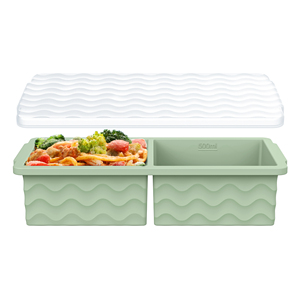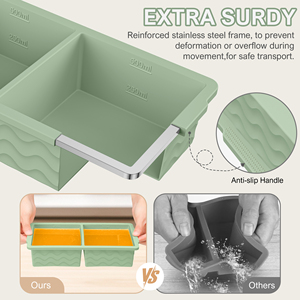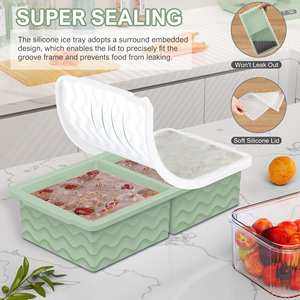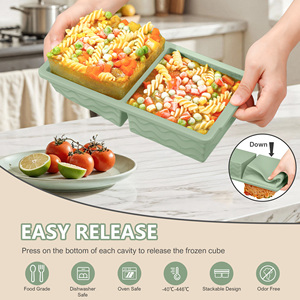
All categories
Featured selections
Trade Assurance
Buyer Central
Help Center
Get the app
Become a supplier

(1302 products available)



















































Silicone ice cream containers are designed to store ice cream and other frozen desserts. They offer flexibility, temperature resistance, and convenience for freezing and serving. Below are some of the commonly used silicone ice cream containers.
Silicone Ice Cream Molds
These are molds for making ice cream pops or ice cream bars. Typically, they have sticks or handles attached for easy eating. They are made of durable silicone, so users can easily extract the pops/bars by pressing the mold. Some ice cream pop molds have compartments for making different flavors simultaneously.
Silicone Pint Containers
Silicone pint containers are similar to traditional ice cream pints but made of silicone. They are often used for packaging non-dairy ice cream. They are recyclable and designed to reduce environmental impact. The design of most silicone pint containers allows them to be reused as storage for other homemade frozen treats.
Silicone Tubes
Silicone tubes are another option for storing ice cream. They are portable and can be taken along while traveling. Some silicone tubes have a twist-open end that allows users to enjoy ice cream or frozen yogurt conveniently. They can be reused multiple times, making them an eco-friendly option for frozen desserts.
Silicone Popsicle Molds
These are molds specifically for making popsicles. They allow users to create popsicles out of ice cream, fruit juice, or yogurt. Most silicone popsicle molds have stick handles for easy removal and consumption. They are flexible and reusable, so they encourage less waste compared to single-use popsicle sticks.
Silicone Ice Cream Tub
Silicone ice cream tubs are designed for storing homemade ice cream. They are often used in conjunction with ice cream makers. These tubs usually come with a lid to prevent ice cream from absorbing odors in the freezer. Some tubs come with double-walled vacuum insulation to keep ice cream at the right temperature for longer.
Flexible Material:
Silicone ice cream containers are made of food-grade silicone, a flexible, durable, and elastic material. This silicone can withstand very high and very low temperatures. This quality allows the containers to be used in the freezer for ice cream and in the oven for baking without the ice cream sticking to the container.
Design Options:
Silicone ice cream tubs are available in many shapes and colors. Some containers have a double-layer design for better insulation and to keep the ice cream cold longer. The silicone used in these containers is often BPA-free and non-toxic, making them safe for storing and consuming ice cream. They can also be designed with features like snap-on lids, handles for easy carrying, or even built-in insulation for on-the-go enjoyment.
Easy to Clean:
Silicone ice cream containers are dishwasher-safe and easy to clean by hand. The surface of silicone containers is resistant to staining and odors, so they stay fresh even after storing different flavors of ice cream. This convenience makes them a practical choice for both home and commercial use.
Aesthetic Appeal:
Silicone containers are often sleek and modern in appearance. Their aesthetic appeal can complement a variety of kitchen and dining decor styles, making them not only functional but also visually pleasing. Whether it's a vibrant color to match a theme or a neutral tone for elegance, silicone containers can fit any preference.
Customization Options:
For businesses, silicone ice cream containers offer the potential for branding. Custom-printed or embossed containers can showcase a logo, flavor name, or other branding elements, helping to distinguish products in a competitive market.
Environmental Impact:
Using silicone for ice cream containers has less environmental impact than other materials. Silicone does not break into small pieces that harm nature. It can be reused and recycled more easily than plastic. Using silicone ice cream containers means producing less trash. They also do not absorb smells or flavors, so the ice cream stays tasty. Even though silicone costs more upfront, it is better for the Earth in the long run. Businesses choose silicone to show they care about the environment.
Silicone ice cream containers are convenient and functional. They have several usage scenarios that show their versatility and practicality. Here are a few key scenarios:
Homemade ice cream
Making ice cream at home is a popular container usage. For those who like DIY food, creating ice cream in silicone tubs is a fun way to control flavors and ingredients. Tubas are suitable for freezing and storing the delicacy until consumption. They also allow for easy and flexible handling of the frozen treat.
Food service industry
Ice cream tubs are extensively used in the food service sector, including restaurants, cafes, and catering businesses. They are employed for serving ice cream to customers or supplying it to events. Their reusable nature makes them an economical and eco-friendly choice for business owners.
Retail and take-home
Silicone buckets containing ice cream are sold in grocery stores and convenience shops. Manufacturers package different flavors and types of ice cream in these containers for retail. The portable design of the tubs allows customers to purchase ice cream and enjoy it at home.
Ice cream trucks and carts
On-the-go ice cream is a popular delicacy during hot weather or at outdoor events. Silicone containers are perfect for storing the frozen delicacy in ice cream trucks or carts. Vendors can use the tubs to serve the sweet treat to customers on the streets or at public gatherings.
Food storage and organization
Aside from holding ice cream, silicone containers can serve multiple other purposes. They can be used for storing other frozen goodies such as sorbets, frozen yogurt, or homemade popsicles. The airtight seal of the tubs helps keep the treats fresh and prevents freezer burn. The clear and stackable design of most silicone containers allows for easy organization and space-saving storage in the freezer.
Allergy-friendly and specialty diets
With the rising demand for allergy-friendly foods, silicone ice cream buckets are becoming a popular choice for serving ice cream made with alternative ingredients. They are used for ice cream made with dairy-free, gluten-free, and nut-free recipes. The containers help prevent cross-contamination and cater to customers with specific dietary requirements.
Opting for the right silicone ice cream container guarantees deliciousness and safety. When choosing, one should think about many things.
One should keep all these things in mind when selecting a silicone ice cream container. They will ensure that the container is the right fit and works as it should. The container will keep the ice cream yummy and safe.
Q1: Can silicone ice cream containers be used in the microwave or oven?
A1: Silicone has a heat resistance that can go as high as 450 degrees Fahrenheit. This means that silicone ice cream containers can be used in the microwave and oven. Nevertheless, it is prudent to check the product specifications to confirm this.
Q2: Are silicone ice cream containers recyclable?
A2: While some types of silicone can be recycled, it is not the same as the silicone used in ice cream containers. The silicone used in these containers has bonded with other materials to form a new product, making recycling difficult. However, silicone is generally more environmentally friendly than plastic or glass. It is essential to clean the container and send it to the proper recycling facility. Many municipalities have programs for recycling silicone. Always check local guidelines to know how to recycle silicone properly.
Q3: How can users remove odors from silicone ice cream containers?
A3: To remove odors from a silicone ice cream container, wash it with warm water and dish soap. If the smell persists, soak the container in a mixture of baking soda and water or vinegar for 30 minutes, then rinse it thoroughly. Using lemon juice can also help eliminate odors.